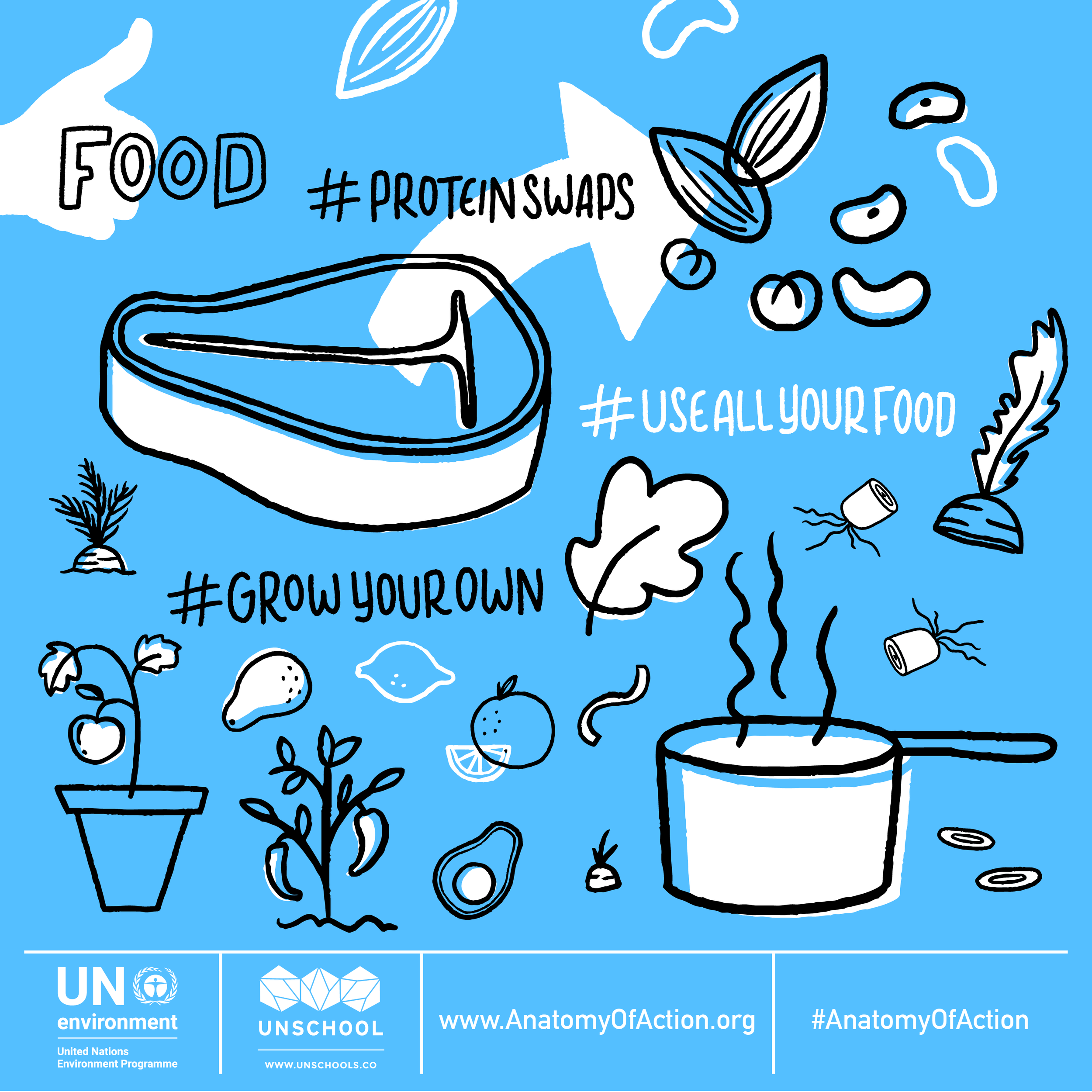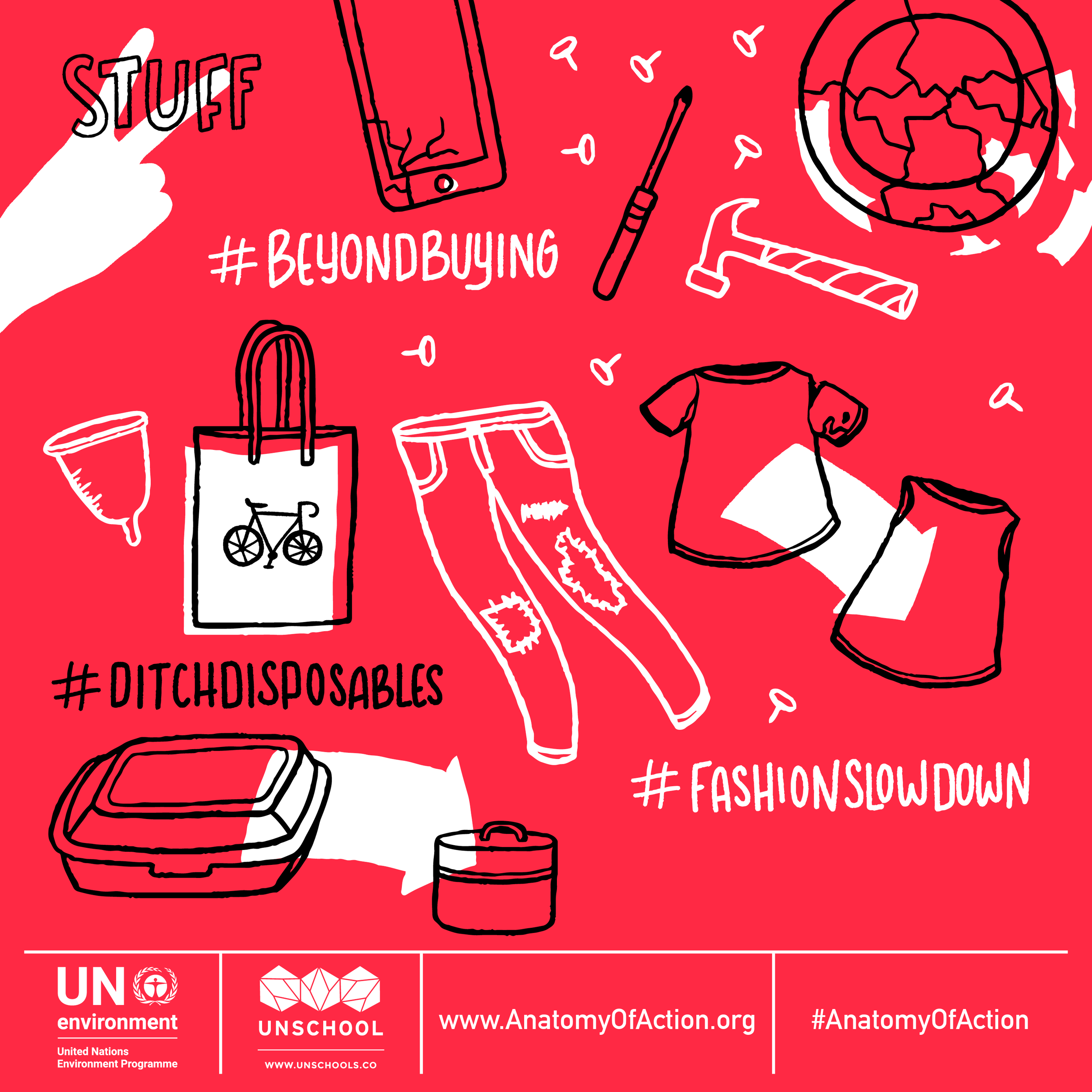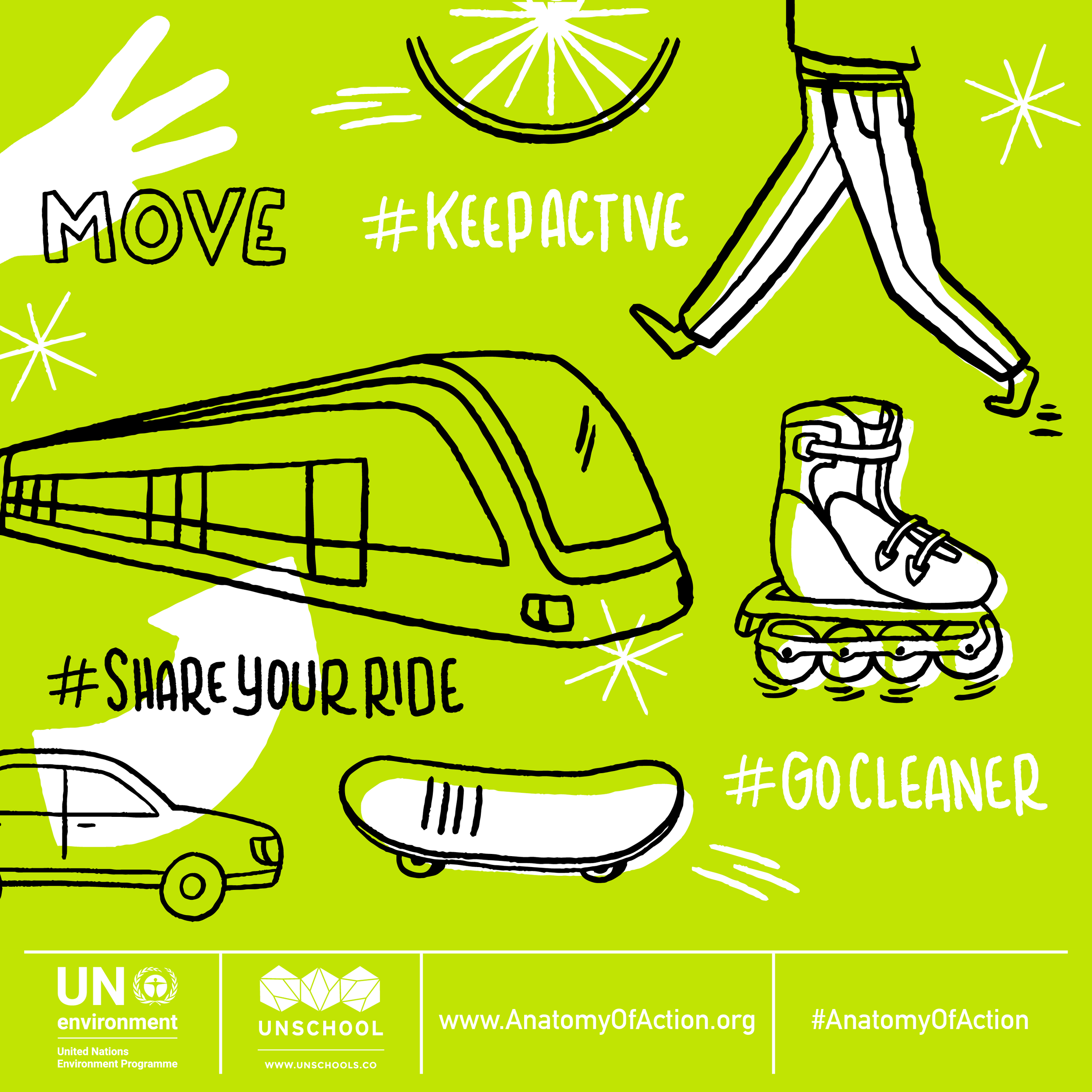By Leyla Acaroglu
Over the last year, the UnSchool team and I have been working on an exciting project in collaboration with the United Nations Environment Programme (UNEP) to activate sustainable living and lifestyles.
The outcome is the Anatomy of Action, and this week, we are launching it into the world!
Here are the how’s and why’s of this exciting new initiative.
When I talk about sustainability, a topic I have spoken about a lot over the last 15 years of my career, people often react in one of three ways: 1. they are really into the idea but don’t know what to do about it; 2. they are openly hostile about it, usually because they have had a bad experience with some form of environmentally-motivated actions/product etc; or, 3. they are confused by what it actually means and whether it is achievable, which makes them feel overwhelmed by it.
I try to remind people that sustainability is about the social, economic, and environmental considerations of what we do in our personal lives, the way we do business, and the government decisions that our elected representatives make on our behalf so that we can sustain the systems (such as food, air, and water) that every single living thing on Earth needs to survive and thrive. What it is not is a hippy-dippy, tree-hugging, wishy washy, anti-business concept that means you have to give up a lot and go back to the ‘dark ages,’ which is literally what some people who fall into the openly-hostile category have said to me. By being human, you need the planet, and as a result of our collective actions, the planet now needs us to alter damaging practices and replace them with more sustainable and regenerative ones.
I will be the first to admit that we have a whole bunch of historical legacy issues to overcome when it comes to sustainability, as, in the past, actions by environmental movements and organizations have accidentally pigeon-holed the ways in which people view and care about the planet. Whilst often very good intentioned, the use of fear and shaming have been two well-executed tools in a space that often ends up being polarized between people who ‘care’ about the planet and those who ‘don’t’ — which is very strange when all people need the planet to live and thus don’t really have the option to not care about it.
There are also many issues with the boom in greenwashing that we are still trying to shake off from industries who spend more money on marketing green credentials rather than doing them, and thus the resulting consumer cynicism from people who feel they were duped into buying crappy, often more expensive, so-called ‘green’ products.
Now, though, we are in a more sophisticated era of understanding the ways in which we can design products and services that meet human needs but don’t destroy the systems that sustain us all. That's really what the core of sustainability as a practice is — a better understanding of systems and how we participate in them, which then leads to more informed and creative decision-making around how we all live well on this shared planet. And by shared, I mean not just with all the 7.5 billion other humans, but also the biological miracle that is the diversity of all the different species that make Earth the only known life-sustaining plant in the universe.
The current trend toward circularizing the economy is, in part, a reaction to the phenomenal waste crisis that we have designed ourselves into. The sad reality is that yes, recycling is broken, and we have global supply chains churning out stuff designed for the dump every second of every day. With many people profiting off this linear system, it does seem hard to turn the tides on such a well-oiled production-to-waste machine.
But now, many of us humans are seeing the feedback loops from this by way of mounds of ocean plastic waste and air pollution, which is one of the world’s biggest killers. In fact, cities around the world regularly peak above the WHO safe living index, and recent studies have shown the link between air pollution and all sorts of cognitive issues like Alzheimer’s disease. And then there is the climate crisis, a massive, scary, overwhelming concept that is freaking many people out. So, what in all of this mess and chaos is one individual to do about this, when we are presented with so many issues in need of solutions like the 17 in the Sustainable Development Goals? How do we overcome the inertia felt by the magnitude of the issues at hand, when we see there are just so many things that need to be addressed and we are just individuals trying to live a good life? How on Earth do we do anything that has any impact at all?
Every issue holds its own solution, and that’s the case here. We each make up the world by the actions we take; the planet is in the state it's in not because we exist, but because we do the things we do each day. Sure, many choices are taken out of our hands and all industries and governments have a lot to answer for when it comes to obtaining a sustainable and positive future. But for each of us, we hold in our own two hands the opportunities to change the economy, as it is made up of all our individual actions accumulated as an economic outcome.
If you have ever worked for a company that sells goods or services, you will know that the trends in consumer behavior are the things that dictate the next steps for the company. So, let’s say you work for a large supermarket chain, and suddenly, people start avoiding overly-packaged products. When you look into why, you discover it's because of the concerns about ocean plastic waste and that there is a trend toward package-free products. So then, you make a case to your boss to have package-free options that meets the rising trend in consumer preferences. That is how the market works — actions breed reactions in the market — so if we want to be a part of designing a future that works better than today, then we need to redesign our lives to mimic the kind of future we want to live in.
The complexity of sustainability is in the fact that we don’t really have all the answers yet. There is much work to do on the technical solutions to meeting our needs in more regenerative and planet-positive ways, like how do we mass-produce carbon-free energy and provide power for transport devices as large as airplanes? But, the very fact that we discovered how to fly was a miracle not too long ago, so the future will result is these issues being addressed, once we have a more widespread acceptance of the base reality that all humans need the planet and that our actions have negative impacts on it that, in turn, negatively impact us all. There is absolutely no escaping this, no matter how much power or wealth you may have.
But, there are many things we can do, and I want to make it really clear that we each have agency and some kind of control over the future we create, even if it doesn’t seem like it at times. We make up the economy through our actions, and in turn, the economic system dictates what we value and how we live our lives. So, we are in a dynamic relationship that often feels as though the way things are is the way things have and will always be. But 10 years ago, smartphones were a brand new thing, and 20 years ago, we all had to plug our desktop computers into a phone line to access this new thing called the Internet. As such, in 10 or 20 years, the future will be very different from today, and I, for one, will be working to ensure that the kind of future we end up in is more equitable, sustainable, and regenerative than today.
This is my very long introduction to a project we have been working on with the United Nations Environment Program’s economic division. For the last year, we have been exploring what types of actions individuals can take that will actually have an impact, if replicated and normalized, as part of people's everyday lifestyle actions. The outcome is the Anatomy of Action, an initiative we will launch this week at UNESCO in Paris. We wanted to not only design something that supports lifestyle changes for sustainable living, but also base it on a deeper understanding of what is working, along with why and how to amplify it so that we get new types of behavioral normals that encourage positive shifts within the economy.
In 2016, I was awarded Champion of the Earth by the UNEP for my work with the UnSchool and my creative products that bring a science-based, innovative approach to sustainability. So it was fitting that we would find a way to collaborate on the complex and fascinating topic of sustainable lifestyles and how to activate more of them.
For this collaboration, my team and I started by shining a light on all the bright spots of organically-growing cultural movements that exist outside of the traditional sustainability or environmental movements — things like zero waste, minimalism, guerilla gardening, ride sharing, etc. We identified over 80 movements, categorized them into which everyday lifestyle areas they were addressing, and then dissected the actions that these movements were identifying and taking. Next, we searched for the last five years of peer-reviewed academic papers and studies to see which of these hundreds of identified actions have positive impacts if amplified out among more people.
This helped us refine the list of actions down into a more detailed action heat map, and from that, we developed the five themes that make up the Anatomy of Action: food, stuff, movement, money, and fun. Experts within the UN system then reviewed the long lists of validated actions and confirmed the high-level ones that we could share as significant actions that anyone can take to have a positive impact in their daily lives.
The resulting 15 sub-actions are all positively framed; for example, we are not asking everyone to go vegan (which is shown will have significantly positive impacts) but instead to ‘protein swap’, which everyone can do a few meals a week. We chose this intentional language because we know that globally, food options are very different, and health conceptions as well as cultural conventions are also very diverse. For me, a protein swap is achievable, and if we get more people doing this, it will encourage meat producers to move away from intensive factory farming and instead, produce high quality, ethical, grass-fed meat, which will result in a better place with many environmental impacts.
The action set presented in the Anatomy of Action shows everyday lifestyle swaps that fit easily into daily lifestyle choices. I drew heavily on behavioral and cognitive sciences to gain an insight into how to frame these actions as opportunities rather than losses, as the reality with sustainability is that it is a massive opportunity! For example, the benefits in swapping your car drive for human-powered transport are massive. Not only do you get exercise, but also the less cars we have in urban environments, the better air quality we get. Additionally, there is a lot of research as to when people disrupt their daily habits and rituals — usually when there are already in an altered life state, such as going on vacation, having a baby, or moving houses. This struck me as fascinating, as we often fall into rutted ways of doing things, and as the old adage goes, “A change is as good as a holiday,” because change often brings positive results for us.
Part of the Anatomy of Action asset set, Illustrations by Emma Segal. See all assets here
In designing and making the Anatomy of Action, I wanted to create a memorable, but simple memetic tool that reminds us all of the choices we make everyday. Nearly everyone has hands and we see them in front of us everyday, doing the things that make up our lives, so this reference is easy to remember when taking actions. But the critical thing is taking action! So to launch the initiative, we are challenging everyone to pick one of the actions, swap to it, and then share your habit disruptions on social media, tagging three friends to challenge them to get started too. Then repeat! For example, I personally moved banks for the UnSchool and started to move over other banks for my personal life because part of the research showed that divestment from banks and energy providers that are relying on the old carbon-producing industries could be done pretty easily. It takes time, for sure, but the outcome is investing in the kind of companies I want to see more of and divesting from the ones that need to change.
Keep in mind that, due to the need to reach a diverse range of humans around the globe who live among different circumstances, the final action set is simply a chunk of things you can start doing now, but there are MANY things you can do and that need to be done. The next stage in our progress toward a sustainable future is discovering the things that we have impact on, both in negative and positive ways, and then designing these so that they are more effective and efficient. That's exactly what we're doing with sustainability — we are researching and working to figure out where the impacts are and what we can each do to address these, in our lives, in our businesses, and through the actions we take everyday that have an impact on the economy.
We need many approaches to communicating, engaging, and activating a sustainable, circular, regenerative future. The Anatomy of Action is just one, but I hope it inspires you to reconsider some of the daily lifestyle choices you make, as well as how we each impact the economy and how, in turn, it impacts us, because the future is made up of our actions today. In doing so, we can all, over time, work to change the narrative of sustainability and design a future that works better than today.


















